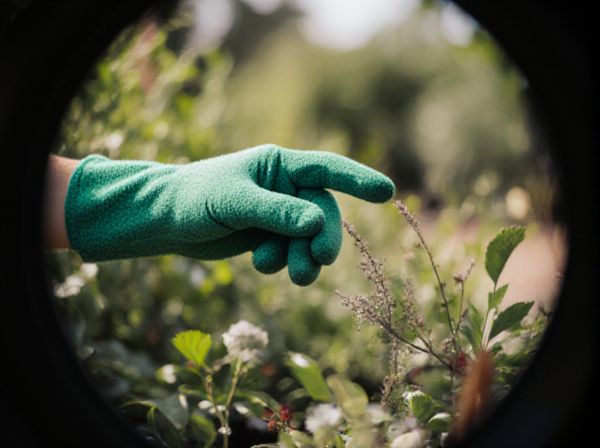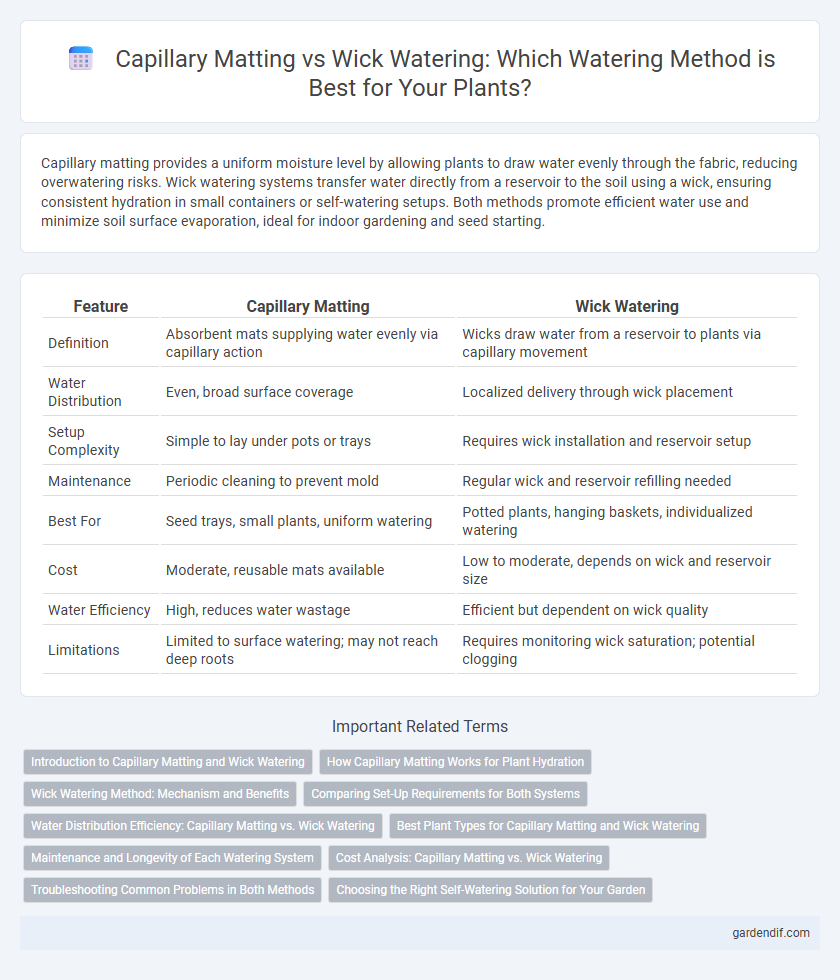
Capillary matting vs Wick watering Illustration
Capillary matting provides a uniform moisture level by allowing plants to draw water evenly through the fabric, reducing overwatering risks. Wick watering systems transfer water directly from a reservoir to the soil using a wick, ensuring consistent hydration in small containers or self-watering setups. Both methods promote efficient water use and minimize soil surface evaporation, ideal for indoor gardening and seed starting.
Table of Comparison
| Feature | Capillary Matting | Wick Watering |
|---|---|---|
| Definition | Absorbent mats supplying water evenly via capillary action | Wicks draw water from a reservoir to plants via capillary movement |
| Water Distribution | Even, broad surface coverage | Localized delivery through wick placement |
| Setup Complexity | Simple to lay under pots or trays | Requires wick installation and reservoir setup |
| Maintenance | Periodic cleaning to prevent mold | Regular wick and reservoir refilling needed |
| Best For | Seed trays, small plants, uniform watering | Potted plants, hanging baskets, individualized watering |
| Cost | Moderate, reusable mats available | Low to moderate, depends on wick and reservoir size |
| Water Efficiency | High, reduces water wastage | Efficient but dependent on wick quality |
| Limitations | Limited to surface watering; may not reach deep roots | Requires monitoring wick saturation; potential clogging |
Introduction to Capillary Matting and Wick Watering
Capillary matting and wick watering both provide efficient, passive irrigation methods ideal for indoor and container plants. Capillary matting consists of absorbent fabric that distributes water evenly across its surface, maintaining consistent moisture levels for plant roots. Wick watering uses a cord or strip made of absorbent material that draws water from a reservoir directly to the soil, ensuring a controlled water supply without over-saturation.
How Capillary Matting Works for Plant Hydration
Capillary matting provides consistent plant hydration through a porous fabric that retains water and allows roots to draw moisture via capillary action. This material maintains an even water supply by distributing moisture uniformly across the mat surface, minimizing overwatering and underwatering risks. Compared to wick watering, capillary matting supports multiple plants simultaneously by managing water levels effectively through its extensive surface area.
Wick Watering Method: Mechanism and Benefits
The wick watering method utilizes a porous wick material to draw water from a reservoir directly to plant roots through capillary action, ensuring consistent moisture levels. This mechanism minimizes overwatering and promotes healthier root development by delivering water gradually and evenly. Key benefits include reduced water waste, low maintenance, and improved plant growth in container gardening and hydroponic systems.
Comparing Set-Up Requirements for Both Systems
Capillary matting requires laying out a large, absorbent fabric beneath pots or trays with a consistent water source, making setup straightforward but space-dependent. Wick watering involves threading wicks from a water reservoir directly into each pot, which demands precise placement and monitoring to ensure effective water transfer. Both systems emphasize simplicity but differ in distribution methods and spatial arrangement needs, impacting installation time and maintenance.
Water Distribution Efficiency: Capillary Matting vs. Wick Watering
Capillary matting provides uniform water distribution by allowing moisture to spread evenly across its surface, ensuring consistent hydration for plant roots. Wick watering relies on narrow wicks to transfer water, which may result in uneven moisture levels depending on wick placement and material absorption rates. Overall, capillary matting offers superior water distribution efficiency, reducing dry spots and maximizing plant growth potential.
Best Plant Types for Capillary Matting and Wick Watering
Capillary matting excels with small to medium potted plants, succulents, and seedlings that require consistent moisture without waterlogging. Wick watering suits plants with moderate to low water demands like African violets, ferns, and herbs, as the wick regulates water uptake efficiently. Both methods support container gardening but differ in moisture delivery suited to specific plant water needs.
Maintenance and Longevity of Each Watering System
Capillary matting offers consistent moisture distribution with minimal maintenance, as it resists mold and algae buildup through regular cleaning and drying, extending its lifespan over several years. Wick watering systems require more frequent inspection to prevent wick deterioration and blockages caused by mineral deposits, which can reduce efficiency and shorten longevity. Choosing capillary matting typically results in lower upkeep and longer-term reliability, while wick systems need attentive care to maintain optimal functioning.
Cost Analysis: Capillary Matting vs. Wick Watering
Capillary matting offers a reusable and durable solution with an initial higher cost but lower long-term maintenance expenses compared to wick watering systems, which are typically cheaper upfront but may require frequent replacements. The material quality and longevity of capillary mats contribute to cost savings over time, especially in large-scale or commercial gardening setups. Wick watering involves simpler components but often increases costs due to wear and the need for consistent monitoring and adjustments.
Troubleshooting Common Problems in Both Methods
Capillary matting and wick watering systems often face issues such as uneven moisture distribution, leading to overwatering or underwatering plants. Troubleshooting involves ensuring proper mat saturation for capillary systems and checking wick placement and material absorbency for wick watering. Regular inspection can prevent root rot and promote consistent hydration by adjusting system components based on plant water requirements.
Choosing the Right Self-Watering Solution for Your Garden
Capillary matting offers a consistent moisture source by evenly distributing water across its surface, ideal for larger container gardens and seed trays. Wick watering relies on a wicking material drawing water from a reservoir, providing a low-maintenance option suited for individual pots or small container clusters. Selecting between capillary matting and wick watering depends on garden size, plant type, and desired maintenance level, ensuring efficient hydration and healthy growth.
Capillary matting vs Wick watering Infographic

 gardendif.com
gardendif.com